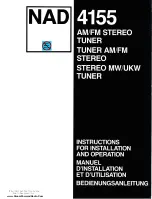
34
OPERATION
Operation
Surround Mode Chart
MODE
FEATURES
DELAY TIME RANGE
DTS Neo:6 Cinema
These two modes are available when any analog source is playing to create a six-channel
Delay time not adjustable
DTS Neo:6 Music
surround presentation from conventional Matrix-encoded and traditional Stereo sources. Select
the Cinema version of Neo:6 when a program with any type of analog Matrix surround encoding
is present. Select the Music version of Neo:6 for optimal processing when a nonencoded,
two-channel stereo program is being played.
DOLBY 3 STEREO
Uses the information contained in a surround-encoded or two-channel stereo program to
No surround channels
create center-channel information. In addition, the information that is normally sent to the
rear-channel surround speakers is carefully mixed in with the front-left and front-right
channels for increased realism. Use this mode when you have a center-channel speaker
but no surround speakers.
THEATER
The THEATER mode creates a sound field that resembles the acoustic feeling of a
Delay time not adjustable
standard live performance theater, with stereo and even pure mono sources.
HALL 1
The two Hall modes create sound fields that resemble a small (HALL1) or
Delay time not adjustable
HALL 2
medium sized (HALL 2) concert hall, with stereo and even pure mono sources.
VMAx Near
When only the two front-channel loudspeakers are used, Harman’s patented VMAx mode
No surround channels
VMAx Far
delivers a three-dimensional sound space with the illusion of “phantom speakers” at the
center and surround positions. The VMAx N, or “Near Field” mode should be selected when
your listening position is less than 1,5 m from the speakers. The VMAx F, or “Far Field” mode
may be selected when your listening position is greater than 1,5 m from the speakers.
The VMAx modes are also available using the
Headphones Output
4
. When headphones
are being used, the Far Field mode will push the sound field away from your ears,
reducing the “inside the head” sensation often experienced when using headphones.
Dolby Virtual Speaker Dolby Virtual Speaker technology uses a next-generation advanced algorithm to reproduce the
No surround channels
Reference
dynamics and surround sound effects of a precisely placed 5.1-channel speaker system using only
Wide
front left and right speakers. In the Reference Mode, the apparent width of the sound across
the front image is defined by the distance between the two speakers. The Wide Mode
provides a wider, more spacious front image when the two speakers areclose together.
5-Channel Stereo
This mode takes advantage of multiple speakers to place a stereo signal at both the front and
No delay available in
7-Channel Stereo
back of a room. Depending on whether the AVR has been configured for either 5.1 or 6.1/7.1
these modes
operation, one of these modes, but not both, is available at any time. Ideal for playing music in
situations such as a party, this mode places the same signal at the front-left and surround-left,
and at the front-right and surround-right speakers. The center channel is fed a summed mono
mix of the in-phase material of the left and right channels.
SURROUND
This mode turns off all surround processing and presents the pure left- and right-
No surround channels
OFF (STEREO)
channel presentation of two-channel stereo programs.
Dolby Headphone
Dolby Headphone enables ordinary stereo headphones to portray the sound of a five-speaker
No surround channels
DH1
surround-playback system. The DH1 mode creates headphone presentation that resembles a small,
DH2
well-damped room and is appropriate for use with both movies and music-only recordings.
DH3
The DH2 mode creates a more acoustically live room particularly suited to music listening.
The DH3 mode creates a larger room, more like a concert hall or movie theater.
















































